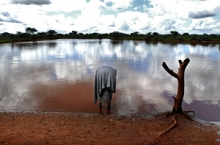
27 Aug, 2012
Droughts Flag Need to Better Manage Water Resources, Safeguard Food Security
|
27 August 2012, Stockholm/Rome (FAO media release) –Drought in some parts of the world has hurt global grain production and contributed to food price spikes virtually every other year since 2007, highlighting the need to transform the way water is used – and wasted – throughout the entire food chain. This is one of the key messages that FAO is transmitting this week at World Water Week in Stockholm, Sweden. The annual event brings policy makers and experts from around the globe together to discuss pressing issues related to water and its management. In a speech made today at the Week’s opening ceremony, FAO Director-General José Graziano da Silva stressed that “there is no food security without water security,” noting that FAO’s recent report, The State of Land and Water Resources for Food and Agriculture, warns that water scarcity and pollution are posing a growing risk to key food production systems around the world.  A dwindling watering hole in Kenya. Drought has disrupted food production in a number of world regions in recent years. “Agriculture, as we practice it today, is one of the causes of this phenomenon, as it represents 70% of all freshwater uses,” said Graziano da Silva. But, he also noted, the food production sector also offers tremendous potential for changing how the world uses water. “Agriculture holds the key to sustainable water use,” said Graziano da Silva. To achieve that and meet the world’s growing demand for food, “we need to produce in a way that conserves water, uses it more sustainably and intelligently, and helps agriculture adapt to climate change” he added. Toward that end, FAO is proposing a new framework for water management in agriculture: Coping with water scarcity: An action framework for agriculture and food security. FAO’s framework stresses in particular the importance of the following areas where policy and action should focus: Modernisation of irrigation: age-old canal irrigation schemes need to be modernized to respond to the needs of tomorrow’s farmers, allow for the more efficient use of water and increase productivity. Future irrigation will increasingly be piped irrigation and combine different sources of water, including groundwater, in a sustainable way. Substitution and reduction of food waste: agricultural policies must consider the potential that rainfed production still offers in many places, and seek a much more integrated combination of irrigated and rainfed farming. At the same time, the reduction of post-harvest losses must be part of any water scarcity coping strategy. Of all food produced globally, 30 percent – the equivalent of 1.3 billion tons – is lost or wasted every year along the value chain from field to fork. Reducing these losses go a long way towards reducing pressuring on natural resources that are essential to food production, like soils and water. Additional information |
|
Oxfam: Today’s rising food prices will trap millions tomorrow – case studiesMillions of the world’s poorest people will face devastation from today’s rocketing food prices because the global food system is fatally flawed and policy-makers can’t find the courage to fix it. Policy-makers have taken cheap food for granted for nearly 30 years. Those days are gone. Developing countries are bracing themselves for the worst effects of rising corn, soy and wheat prices on their poorest people. Fragile populations around the world, living on or near the poverty line, will be dragged under by price spikes and volatility. Nearly a billion people are already too poor to feed themselves, so any long-term food spike is guaranteed to trap millions more who are now just “getting by”. Worrying too is the continuing drop in global corn stocks that are now at their lowest levels for six years . History is repeating itself and will keep doing so until we tackle the fundamental weaknesses that keep a billion people hungry.
Here’s Oxfam’s analysis of 2012 food price hikes (pdf 237kb) Learn more about Food Prices Spikes |



Liked this article? Share it!